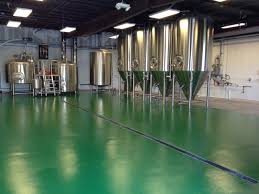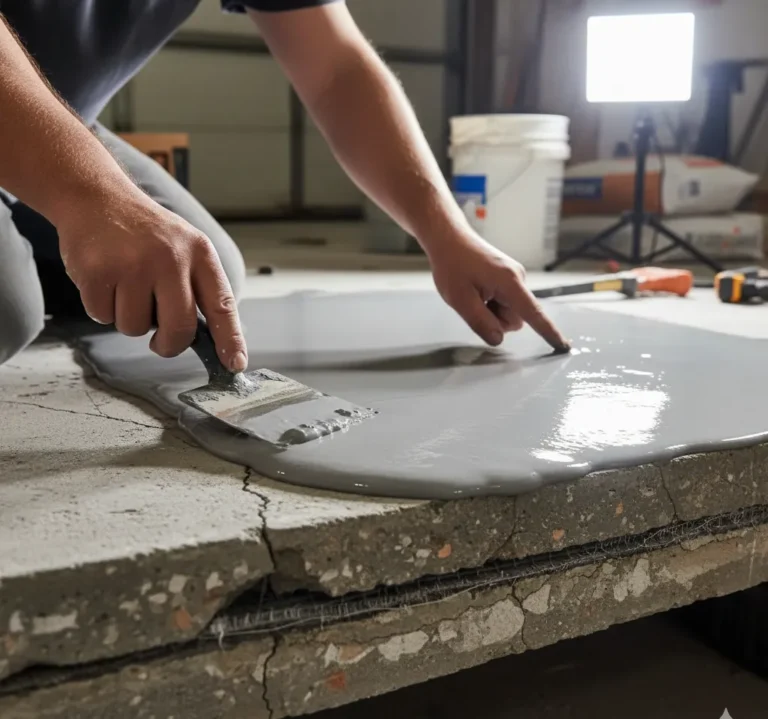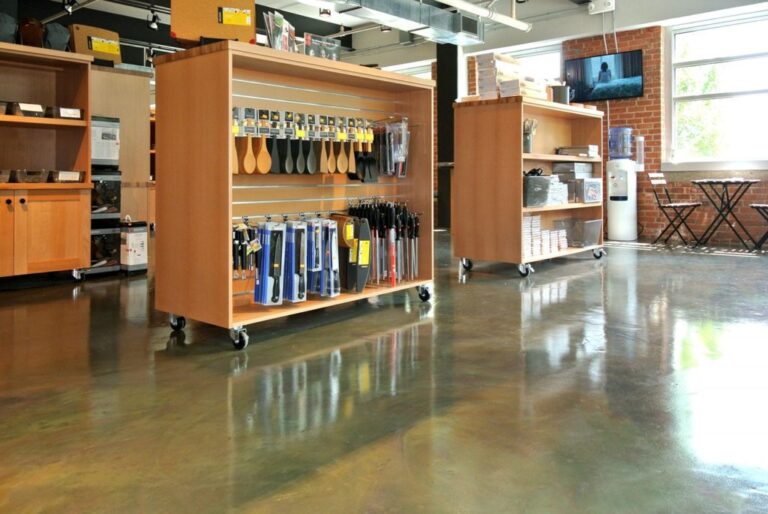Concrete Surface Preparation using Gelled Acid
Concrete surface preparation is a crucial step in ensuring the longevity and performance of concrete structures. Gelled acid has emerged as a powerful tool in this process, offering unique advantages over traditional liquid acid etching methods. This innovative approach to concrete surface preparation combines the effectiveness of acid etching with the controlled application of a gel-based product.
What is Gelled acid for concrete surface preparation?
Gelled acid for concrete surface preparation is a specialized formulation designed to etch and profile concrete surfaces effectively. Unlike liquid acids, gelled acids adhere to vertical and horizontal surfaces, allowing for more precise application and reduced risk of splashing or runoff. This characteristic makes gelled acid particularly useful for a wide range of concrete preparation projects, from residential floors to industrial surfaces.
Key benefits of using gelled acid for concrete surface preparation:
- Improved control and precision during application
- Reduced risk of over-etching or damaging the concrete
- Enhanced safety for workers due to minimized splashing
- Ability to work on vertical surfaces without excessive runoff
- More uniform etching results compared to liquid acids
Benefits of Gelled Acid for Concrete Etching
Improved adhesion for coatings and sealers
Gelled acid etching creates a porous surface profile that significantly enhances the adhesion of subsequent coatings and sealers. This improved bonding capability ensures that protective layers and decorative finishes adhere more securely to the concrete substrate, resulting in longer-lasting and more durable surfaces.
Enhanced surface profile for decorative finishes
The controlled etching action of gelled acid produces a consistent and uniform surface profile ideal for decorative concrete finishes. This enhanced texture allows for better color penetration and adhesion of stains, dyes, and other decorative treatments, resulting in more vibrant and long-lasting aesthetic effects.
Controlled application and reduced splashing
One of the primary advantages of gelled acid is its ability to cling to surfaces without excessive runoff or splashing. This characteristic not only improves safety for workers but also allows for more precise application, especially on vertical or sloped surfaces. The reduced splashing also minimizes the risk of damage to surrounding areas or materials.
Benefits comparison: Gelled Acid vs. Liquid Acid
|
Feature |
Gelled Acid |
Liquid Acid |
|
Application control |
High |
Low |
|
Vertical surface use |
Excellent |
Poor |
|
Splashing risk |
Minimal |
High |
|
Etching uniformity |
Consistent |
Variable |
|
Worker safety |
Improved |
Standard |
Types of Gelled Acid Products 
Hydrochloric acid-based gels
Hydrochloric acid-based gelled products are among the most potent and widely used options for concrete surface preparation. These gels are highly effective in removing laitance, efflorescence, and other surface contaminants. They are particularly suitable for heavily soiled or dense concrete surfaces that require aggressive etching.
Phosphoric acid-based gels
Phosphoric acid-based gelled products offer a milder etching action compared to hydrochloric acid gels. These formulations are ideal for lighter etching requirements and are often preferred for decorative concrete applications. Phosphoric acid gels also have the added benefit of leaving behind a residue that can help neutralize the surface, reducing the risk of efflorescence.
Citric acid-based gels
Citric acid-based gelled products are the mildest option among acid etching gels. These environmentally friendly formulations are suitable for light etching and cleaning of concrete surfaces. While less aggressive than hydrochloric or phosphoric acid gels, citric acid gels are often preferred for their lower toxicity and eco-friendly properties.
Comparison of Gelled Acid Types:
- Hydrochloric acid gels: Most aggressive, best for heavy-duty etching
- Phosphoric acid gels: Moderate etching, suitable for decorative applications
- Citric acid gels: Mild etching, environmentally friendly option
Safety Precautions for Handling Gelled Acid
Personal protective equipment (PPE)
When working with gelled acid products, proper personal protective equipment is essential to ensure worker safety. This includes:
- Chemical-resistant gloves
- Safety goggles or face shield
- Protective clothing (long sleeves, pants, and closed-toe shoes)
- Respiratory protection (if working in poorly ventilated areas)
Always consult the product’s Safety Data Sheet (SDS) for specific PPE requirements and follow manufacturer recommendations.
Proper ventilation
Adequate ventilation is crucial when using gelled acid products for concrete surface preparation. Ensure that the work area is well-ventilated to prevent the buildup of harmful fumes. If working indoors, use fans or open windows and doors to promote air circulation. In some cases, mechanical ventilation systems may be necessary to maintain safe air quality levels.
Spill containment and neutralization
Preparing for potential spills is an essential aspect of safe gelled acid handling. Keep neutralizing agents, such as baking soda or lime, readily available in the work area. Establish a designated spill containment zone and have absorbent materials on hand to quickly address any accidental spills. Proper training in spill response procedures is crucial for all workers involved in the concrete surface preparation process.
Safety Checklist for Gelled Acid Handling:
- Review and understand the product’s Safety Data Sheet (SDS)
- Ensure all required PPE is available and in good condition
- Check ventilation systems and set up additional fans if needed
- Prepare spill containment materials and neutralizing agents
- Conduct a safety briefing with all workers before starting the project
Pre-Application Steps for Concrete Surface Preparation
Surface cleaning and degreasing
Before applying gelled acid, it’s crucial to thoroughly clean and degrease the concrete surface. This step removes dirt, oil, grease, and other contaminants that could interfere with the etching process. Use a high-quality degreaser and scrub the surface with a stiff-bristled brush or mechanical scrubber. Rinse the surface thoroughly with clean water and allow it to dry completely.
Moisture testing
Conducting a moisture test is essential to ensure the concrete is suitable for acid etching. Excessive moisture content can lead to poor etching results and potential issues with subsequent coatings or sealers. Use a reliable moisture meter or perform a simple plastic sheet test to assess the moisture levels in the concrete. If moisture levels are too high, allow additional drying time or consider alternative surface preparation methods.
Repair of cracks and imperfections
Inspect the concrete surface for cracks, spalls, or other imperfections. Address these issues before applying gelled acid to ensure a uniform etching result. Use appropriate concrete repair products, such as epoxy fillers or patching compounds, to fix any damage. Allow repairs to cure fully before proceeding with the acid etching process.
Pre-Application Checklist:
- Remove all loose debris and sweep the surface clean
- Degrease the concrete using an appropriate cleaner
- Perform moisture testing to ensure suitable conditions
- Repair cracks, spalls, and other surface imperfections
- Allow the surface to dry completely before acid application
Application Techniques for Gelled Acid
Brush application
Brush application is a common method for applying gelled acid to concrete surfaces. This technique allows for precise control and is particularly useful for smaller areas or detailed work. Use a chemical-resistant brush with stiff bristles to apply the gelled acid evenly across the surface. Work in small sections, ensuring complete coverage and maintaining a wet edge to prevent lap marks.
Roller application
For larger surfaces, roller application can be an efficient method for applying gelled acid. Use a chemical-resistant roller with a medium nap to distribute the gel evenly. This technique is particularly effective for horizontal surfaces and can help achieve a more uniform application compared to brush application. Work in manageable sections, overlapping slightly to ensure complete coverage.
Spray application
Spray application of gelled acid can be an effective method for covering large areas quickly. Use a low-pressure sprayer designed for acid-resistant materials. This technique requires careful control to ensure even coverage and prevent overspray. When using spray application, it’s essential to maintain proper safety precautions, including appropriate PPE and adequate ventilation.
Application Tips for Gelled Acid:
- Always follow manufacturer instructions for specific application techniques
- Maintain consistent coverage to ensure uniform etching results
- Work in small sections to prevent the acid from drying before neutralization
- Avoid walking on or disturbing the gelled acid during the etching process
- Monitor application time carefully to prevent over-etching
Neutralization and Residue Removal
Importance of neutralization
Neutralization is a critical step in the gelled acid etching process. It stops the acid reaction and prevents ongoing etching or damage to the concrete surface. Proper neutralization also helps prepare the surface for subsequent coatings or sealers by restoring the pH balance of the concrete.
Proper neutralizing agents
Common neutralizing agents for gelled acid include:
- Baking soda (sodium bicarbonate)
- Ammonia
- Trisodium phosphate (TSP)
- Commercial neutralizing solutions
Choose a neutralizing agent compatible with the specific gelled acid product used. Always follow manufacturer recommendations for the most effective neutralization process.
Thorough rinsing techniques
After neutralization, thorough rinsing is essential to remove all acid residue and neutralizing agents from the concrete surface. Use clean water and a high-pressure washer or hose to rinse the surface multiple times. Pay special attention to corners, edges, and any textured areas where residue may accumulate. Continue rinsing until the rinse water runs clear and shows a neutral pH when tested.
Neutralization and Rinsing Steps:
- Apply the neutralizing agent evenly across the etched surface
- Allow the neutralizer to work for the recommended time (usually 5-10 minutes)
- Scrub the surface gently with a stiff-bristled brush to ensure complete neutralization
- Rinse the surface thoroughly with clean water, starting from the highest point
- Test the rinse water pH to ensure complete neutralization (aim for a pH of 7)
- Allow the surface to dry completely before proceeding with any coatings or sealers
Post-Treatment Surface Evaluation 
pH testing
After neutralization and rinsing, it’s crucial to verify that the concrete surface has returned to a neutral pH. Use pH test strips or a digital pH meter to check various areas of the treated surface. A neutral pH (around 7) indicates that the acid has been fully neutralized and the surface is ready for further treatment or coating.
Water absorption test
Performing a water absorption test helps assess the effectiveness of the etching process. Sprinkle water droplets on various areas of the treated surface. If the water beads up or doesn’t absorb quickly, additional etching may be necessary. Properly etched concrete should readily absorb water, indicating an open pore structure suitable for coating adhesion.
Visual inspection for uniform etching
Conduct a thorough visual inspection of the etched surface to ensure uniform results. Look for:
- Consistent surface texture across the entire treated area
- Absence of smooth or glossy spots that may indicate inadequate etching
- No visible residue or discoloration from the acid or neutralizing agents
If any issues are identified during the post-treatment evaluation, address them before proceeding with sealing or coating applications.
Post-Treatment Evaluation Checklist:
- Perform pH tests at multiple locations across the treated surface
- Conduct water absorption tests to verify proper etching
- Visually inspect the entire surface for uniformity and completeness of etching
- Address any areas that show signs of inadequate etching or residual contamination
- Document the evaluation results for future reference and quality assurance
Sealing and Coating Options After Gelled Acid Treatment
Penetrating sealers
Penetrating sealers are an excellent option for protecting acid-etched concrete surfaces while maintaining their natural appearance. These sealers penetrate the porous surface, creating a protective barrier against moisture and stains. They are particularly suitable for exterior applications or areas where a natural concrete look is desired.
Epoxy coatings
Epoxy coatings provide a durable, high-performance finish for acid-etched concrete surfaces. These coatings offer excellent chemical and abrasion resistance, making them ideal for industrial and commercial applications. Epoxy coatings can also be customized with color and decorative flakes to enhance the aesthetic appeal of the concrete surface.
Decorative concrete finishes
Acid-etched concrete surfaces provide an excellent foundation for various decorative finishes. Options include:
- Concrete stains and dyes
- Metallic epoxy coatings
- Stamped overlays
- Microtopping and skim coats
These decorative finishes can transform the appearance of the concrete while benefiting from the improved adhesion provided by the acid etching process.
Comparison of Post-Treatment Coating Options:
|
Coating Type |
Durability |
Appearance |
Application Complexity |
|
Penetrating Sealers |
Moderate |
Natural |
Low |
|
Epoxy Coatings |
High |
Glossy/Customizable |
Moderate |
|
Decorative Finishes |
Varies |
Highly Customizable |
High |
Troubleshooting Common Issues
Uneven etching
Uneven etching can occur due to inconsistent acid application or varying concrete density. To address this issue:
- Re-apply gelled acid to areas with insufficient etching
- Use mechanical abrasion methods to even out the surface profile
- Consider a second, lighter etching pass over the entire surface
Residual acid effects
If pH testing reveals lingering acidity, take the following steps:
- Re-neutralize the surface using a stronger neutralizing solution
- Perform additional rinsing cycles with clean water
- Allow extended drying time before applying any coatings or sealers
Efflorescence formation
Efflorescence, a white powdery substance, may appear on the concrete surface after acid etching. To mitigate this issue:
- Thoroughly rinse the surface to remove all acid and neutralizing residues
- Use a commercial efflorescence remover if the problem persists
- Apply a penetrating sealer to prevent future efflorescence formation
Troubleshooting Tips:
- Document any issues encountered during the etching process
- Consult with the gelled acid manufacturer for product-specific troubleshooting advice
- Consider professional assistance for complex or persistent problems
- Perform small-scale tests when trying new solutions to avoid exacerbating issues
Maintenance of Acid-Etched Concrete Surfaces
Regular cleaning procedures
Maintain acid-etched concrete surfaces with regular cleaning to preserve their appearance and performance. Use pH-neutral cleaners and avoid harsh chemicals that could damage the surface or any applied sealers. Sweep or vacuum regularly to remove abrasive particles that could wear down the surface over time.
Resealing schedules
Establish a resealing schedule based on the type of sealer used and the level of traffic or exposure the surface experiences. Penetrating sealers typically require reapplication every 3-5 years, while topical sealers may need more frequent maintenance. Regular inspections can help determine when resealing is necessary.
Stain prevention techniques
Implement stain prevention strategies to protect acid-etched concrete surfaces:
- Use mats or rugs in high-traffic areas
- Clean up spills promptly to prevent staining
- Apply a stain-resistant sealer in areas prone to oil or chemical exposure
- Avoid dragging heavy objects across the surface to prevent scratches
Maintenance Best Practices: Diamond grinding concrete uses special machines with diamond-tipped blades to smooth and level concrete surfaces
- Develop a regular cleaning and inspection schedule
- Use only recommended cleaning products for the specific surface treatment
- Address any damage or wear promptly to prevent more extensive issues
- Keep records of maintenance activities and resealing dates
- Educate facility users on proper care and stain prevention techniques
Environmental Considerations
Proper disposal of acid waste
Responsible disposal of acid waste is crucial for environmental protection. Neutralize all acid residues before disposal and follow local regulations for chemical waste management. Many areas require special handling and disposal procedures for acid-containing materials, so consult with local authorities or waste management professionals for guidance.
Low-VOC product options
Consider using low-VOC (Volatile Organic Compound) gelled acid products and sealers to minimize environmental impact and improve indoor air quality. Many manufacturers now offer eco-friendly alternatives that provide effective etching while reducing harmful emissions.
Eco-friendly alternatives to acid etching
For projects with strict environmental requirements, consider alternative surface preparation methods:
- Mechanical grinding or shot blasting
- Non-acid chemical etchers
- Bio-based etching solutions
While these methods may not be suitable for all applications, they can provide effective surface preparation with reduced environmental impact in many cases.
Environmental Best Practices:
- Research and comply with local regulations for chemical use and disposal
- Choose low-VOC and eco-friendly products when possible
- Implement proper containment and spill prevention measures
- Consider alternative surface preparation methods for environmentally sensitive projects
- Educate workers on the importance of environmental stewardship in concrete surface preparation
FAQs
What is the difference between gelled acid and liquid acid for concrete surface preparation?
Gelled acid is thicker and stays on vertical or uneven surfaces better, providing more controlled etching. Liquid acid is less viscous, making it suitable for horizontal surfaces but less effective on vertical or textured areas.
How long should gelled acid be left on the concrete surface during the etching process?
Gelled acid should be left on the concrete surface for about 15 to 30 minutes, depending on the product’s instructions and the surface condition.
Can gelled acid be used on all types of concrete surfaces?
Gelled acid is versatile and can be used on most concrete surfaces, including vertical and horizontal ones. However, its effectiveness may vary depending on the texture and condition of the concrete.
What are the signs of successful concrete surface preparation using gelled acid?
Successful preparation is indicated by a clean, etched surface with a rough texture. The concrete should have a uniform appearance without any remaining residue or gloss.
How soon can I apply a coating or sealer after using gelled acid for concrete surface preparation?
You can usually apply a coating or sealer after the concrete has fully dried, which typically takes 24 to 48 hours. Ensure that the surface is completely dry and free of any residual acid before application.





